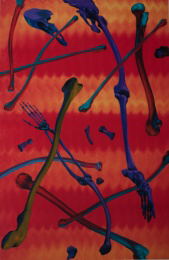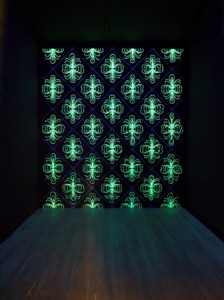Wedhar Riyadi comes before our eyes again with his recent artworks. He is happily busy with bones, after recent stints with pop cultures. Violence stays important as the main theme, though the leaps are way extreme.

Wedhar Riyadi, Still Life,, 76,5x56cm, watercolor-ecoline-guache, 2013
Wedhar Riyadi greets us again with his new artworks in Ardnt Gallery, Berlin, Germany. Riyadi is no longer the previous Riyadi. The previous Riyadi brought forth pop culture artworks that crash local and global cultures. The initial artworks were brightly colored, featuring comical characters from both Eastern and Western pop culture with a dash of soft violence. The awareness of pop culture visual influence felt so real in Wedhar’s artworks.
His name is famous in Indonesian fine arts due to his partiality to pop culture shapes and colors. The celebration doesn’t solely belong to Wedhar, but also a widely-grasp object of the young artist of his generation. Five years after 2005, the pop culture influence spreading through comic books, popular movies, illustration in themed magazines also game features in electronic devices appear in mainly two-dimensional artworks. The frequent existence of said culture takes the viewers and audiences to, sometimes, a surfeited point. Artworks tend to turn into one, general idea and lose the visual persuasion power. The reason why that happens is that the pop culture which is based on an industry has efficiently created and moved the changes through media. On the other hand, there is a limitation of creation and energy in facing and acting critically against the invasion of pop culture.
Manipulation, Oil on Canvas, 220x145cm, 2013
Wedhar, however, is not even remotely close to that. By taking the violence theme some steps further and searching for new symbols, Wedhar can be labeled as making “cracks” if compared to his previous artworks. His artworks become reflective with the nonexistent figure of both local and international heroes. In this occasion, Wedhar brings bones, not anything else, in his paintings and his three-dimensional artworks. The selection of colors is bleak and far from, say, bones as symbols of violence. It is only a personification of a word; grim.
“His present artworks are vital leaps in finding his aesthetics vision; from narration to abstraction, from realism to essentialism, from pop culture representation to reflection of ideas. Interestingly, out of the changes of shapes and approach, the artist maintain the use of domestication,” said Alia Swastika, the curator.
An exhibition titled Bones After Bones: The Shadow from November 15th 2013 to January 25th 2014 displays 8 artworks made throughout 2013. The artworks consist of seven, two dimensional artworks and one, three dimensional artwork. Wedhar uses oil paint on canvas for his two dimensional artworks, one watercolor paint on paper, one ink on paper and one acrylic paint on paper.
Ambience of Wedhar Riyadi’s exhibition in Ardnt Gallery, Berlin, Germany.
Still Life, 76.5×56 cm (2013) is a painting an arm bone on a pot. The painting does not represent a cactus plant on a pot, but a bluish white, spread palm bone with a background of black color and frame in blue and purple. The palm bones are seen focused on one side, but that is nowhere near celebration. The visible thing is that an association of bone as the body’s main support, seen on its own without any flesh or blood.
A stark difference of silence and movement is visible in Melt Away; 76.5×56 cm size, Manipulation; 220×145 cm size and Portal #2 76.5×56 cm, all made in 2013. These artworks consist of seemingly moving bones. Melt Away, ink on paper painting, manages to present a moving condition of black-colored background absorbed by the paper and the rest originally white-colored paper, adorned with green-colored palm bones. The bones are painted curved, not in its exact form.
In Manipulation, the object painted is still bones but the bones are seen distorted. The bones are seemingly scattered in the air due to the nonexistent background, save for the color of maroon and reddish white. In Portal #2, bones of a mouth are painted wide opened with bright and bleak, messy background, turning the situation dramatic on the bones complete with a set of teeth. The expression, thus, turns into the one of pain.
The Wall 3, resin polyster with phosphor colouring, variable dimensions, 2013. Photos: Bernd Borchardt
The artworks in this exhibition show a reality distortion through the distorted bones, both in shapes and the use of vivid colors namely the colors on TV, LCD screen, and stage lighting.
“This distortion also represents the news of violence, conflict, massacre or murder we see that exist in some versions, even distorted ones. At the end, it is only the essential part staying on our mind. Also, it is affirmative that not unlike bones, the representation of human body, the truth of history itself is stored only as an artifact,” said Alia Swastika.***









